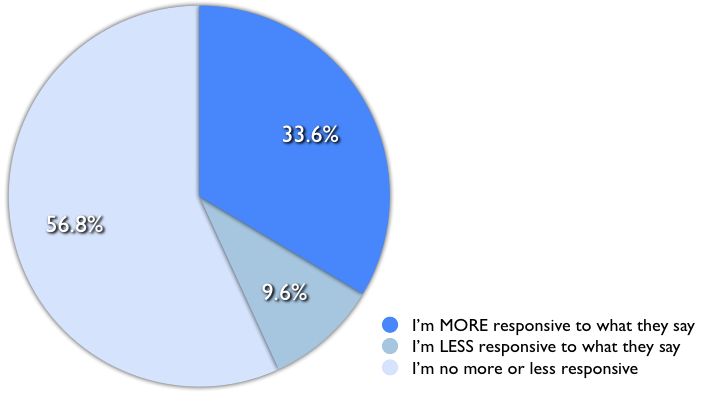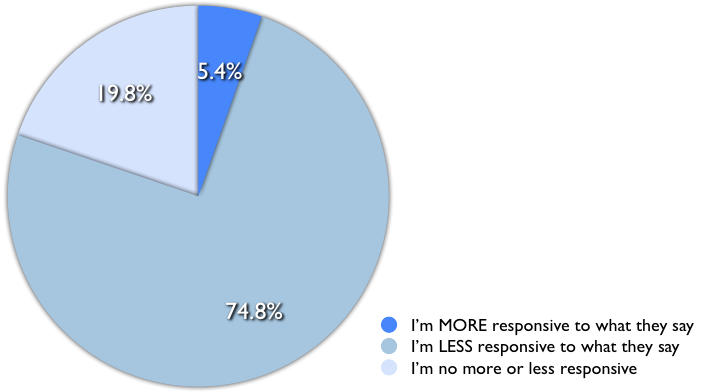We usually have a goal in mind when we set out to write something. Many times, we’re trying to convince our reader of something. Buy a product. Hire me. Admit me to your college. Join me in a crusade of world-dominance. Choose me to be your new roommate. You get the idea.
But we often fail to harness the power of words fully. Unlike with spoken conversation, we can write, revise, and rewrite every paragraph, or even every sentence or word. But we usually don’t.
You know that perfect comeback that would have been epicly awesome if only you’d thought of it five minutes earlier? When you write, there’s no such thing as five minutes too late. You can ensure you present the true ideal you: intelligent, well-spoken, and confident.
Unfortunately, we don’t write nearly as much as we speak, and conveying all of these desirable traits isn’t as easy as it sounds. I’ve read, edited, and improved countless essays, personal statements, blog posts, and more as a Kibin proofreader and editor. Time and time again, writers fail to assist in shaping their reader’s perception of them and convey true confidence.
When I see this happen, I always recommend the writer use a simple, powerful, and easy-to-implement persuasive writing technique I call subconscious framing. To be honest, I’m a bit sick of typing out this explanation over and over again in the closing comments of the papers I edit. And, if only in an effort to save my laptop keys’ labels from anonymity and to enjoy the luxury of lazily copying and pasting a link, I’m going to tell you how to leverage this persuasive writing technique yourself.
After reading this blog post, you will be impressed and excited with how subconscious framing helps you land the job of your dreams, get better grades on your essays, or proves that your business or service is exactly what potential customers are seeking. If you’re trying to convince your readers with persuasive writing, you want to continue reading.
What exactly is subconscious framing?
Subconscious framing is a persuasive writing technique that is easily used in virtually any piece of writing where your goal is to convince your reader of something. In fact, I’ve already used the technique in this blog post.
But before we get into how to leverage subconscious framing, let’s talk about what it is exactly. Remember, I coined this term after reading and editing a myriad of written pieces on Kibin and came up with the following definition:
Subconscious framing is the act of shaping a favorable perception that is in-line with your intent while portraying confidence where most writers mistakenly tend to communicate uncertainty.
Sounds simple, right? All you have to do is sound confident rather than uncertain. Once you do that, your reader will form an opinion that favors your objective. Then, you get what you want, conquer the world, get bored, invent a time-machine, and go back to do it all over again just for fun.
Sounds exquisite, but why do I need this confidence stuff? Can’t I just conquer the world straight-away?
Well, like the atom, confidence is the building block of subconscious framing. To prove how important confidence is, we asked 1,000 people how an individual portraying confidence affects their responsiveness to what that person says. Here are the results:
Now, you may be thinking “Hmmm… only 33% will think I’m a super-genius mastermind and succumb to my literary trickery?”
Yes and no.
You see, while there’s a clear benefit to sounding confident, the real danger is in failing to come across as confident. With so many people already insecure about their writing, it’s pretty easy for their writing to also lack confidence.
Since I decided to swear off making random crap up when I was eight, I asked another 1,000 individuals how people they perceive as lacking confidence affect their responsiveness to what those individuals say:
Ouch!
If you aren’t sounding confident, you’re most likely being perceived quite negatively. As you can see, nearly 75% of people said that they are less responsive to those who fail to display confidence. But displaying confidence is only half of the subconscious framing technique. We also need to do a little “framing,” or helping our reader picture our favorable scenario. If we can nail both of these aspects, we’ll be well on our way to mastering persuasive writing.
Sweet, but what do you mean by “framing”?
Framing is a powerful way of helping your reader visualize the thing you’re trying to accomplish. But don’t take my word for it. Check out this thought-provoking study about how visual perspective in mental imagery affects self-perception and behavior.
If you’re too lazy to click that link, or you’re thinking “visual perspective whaaaaaat?!!!?!,” here’s the gist:
Some smart dudes and dudettes did a study where they had people in Ohio visualize themselves voting in both the first and third-person. Those that performed this visualization in the third-person displayed a stronger pro-voting mindset than those that visualized in the first-person. This effect actually carried over to their behavior, causing the individuals who pictured themselves voting from the third-person perspective to be significantly more likely to vote in the election.
That’s cool, but what the $(@!** does it all mean?!?!!
Basically, if you get your readers to visualize you doing or being something, they will develop a pro-”you” mindset. They’ll become an advocate for your cause.
Painting a vivid, mental picture for your readers sways them to do what you want whether that’s invite you in for an interview, accept your college application, stop killing chinchillas, or buy your product/service. That is the power of persuasive writing!
This sounds awesome, but how about some examples?
I thought you’d never ask! Let’s get started:
Personal statement pitfall
I recently edited a college personal statement that ended with something like this:
“I believe that my background, experiences, and cultural upbringing would be a valuable addition to the University of Michigan’s diverse student body.”
Why it sucks:
When I read stuff like this, I can’t help but shake my head.
There are two problematic areas with this sentence; both of them result in a lack of confidence and subconscious uncertainty in the reader’s mind.
First, the phrase “I believe that…” is weak. As the reader, if I stop and truly think about this, I might start asking questions: “You believe? Does this mean you aren’t sure? If you aren’t sure, why should I be sure?”
Although it may not have been the writer’s intention, this shows a huge lack of confidence.
The second problematic phrase is “…would be a…” Unlike the first phrase, this one is not problematic because of a lack of confidence; rather, it fails to take advantage of an opportunity to frame with imagery. If your readers stop and think about this sentence, they may think to themselves: “Yes, perhaps this person might be a good addition, but I don’t know for sure. I’m not convinced, and I just can’t picture it.”
How to win with truly persuasive writing:
So how can you revise this personal-statement sentence to change your reader’s perception? Try reworking it to something like this:
“I know that my background, experiences, and cultural upbringing will be a valuable addition to the University of Michigan’s diverse student body.”
Notice how the bold areas represent words and phrasing that portray confidence while the italics represent the use of framing (the two can also overlap). By replacing “I believe that…” with “I know that…,” you don’t give your reader the chance to second guess you. Furthermore, by replacing “would be” with “will be” you are now helping your reader envision you as an admitted student in a confident manner.
If you have a personal statement or admission essay and want to make sure you aren’t missing any spots where you could be leveraging subconscious framing, check out our personal statement editing service. Our awesome editors will help!
Cover-letter catastrophe
Cover letters are another area where I see people fail to leverage subconscious framing. Unfortunately, sentences like this one are all too common:
“I feel that I have the skills and experience to excel in this position. I appreciate your consideration of my application to become a Kibin editor.”
Why it sucks:
This sentence is weak. It lacks confidence or any element of framing imagery. With our previous example in mind, you should be able to pick out the weak spots. The word “feel” should now set off a red flag, and the entire second sentence is pretty pathetic as a whole.
How to kick butt with persuasive writing:
Luckily, this sickly snippet of cover-letter text is easy to beef up:
“I know that my skills and experience are a perfect match for this position. I look forward to excelling as a Kibin editor.”
This small tweak makes a world of difference. To someone who evaluates Kibin editor applicants (meaning yours truly), it leaves a very positive, solid final impression.
Although this persuasive writing technique is simple on the surface, subconscious framing takes practice and experience to be able to notice where you’re failing to utilize it. It’s also easy to miss opportunities to leverage persuasive writing if you’re not familiar with it. Luckily, Kibin editors are all familiar with this technique, and our proofreading services will help you portray confidence in anything you write.
What are some other words I should be avoiding?
If you’re sold on the subconscious framing persuasive writing technique but fear you may be overlooking the problematic areas in your writing, use these words as queues:
think/feel/believe
If you’re including these words in sentences, you’re painting a weak, timid, and unsure view of yourself in your reader’s mind. If someone told you “I believe that I am the most talented hopscotcher in the world,” would you believe it?
Probably not.
But if that same person said “I know I am the most talented hopscotcher in the world”… well, you still may not believe it, but the confidence sure would make you pause and consider whether or not the person possesses the hopscotch chops for the world-title.
if
When you use “if,” like in our personal-statement example above, you’re missing out on a huge opportunity to paint a visual picture. Sentences like “If accepted…” or “If admitted…” are easily transformed to paint favorable visual imagery.
Simply saying “As a student at…” or “As a [company name] employee, I…” will have a much more lasting effect on your reader and gives you a leg up on the competition.
would/could
Many times people get halfway there with subconscious framing with sentences like “I could/would make a difference in your organization by flaunting my awesome limbo skills at company picnics.”
The second half of this section is great by painting a visual image with a specific example (and honestly, who doesn’t love an amazing limboer?). However, it ultimately falls flat because the first half of the sentence isn’t forward-looking. Could and would are easily replaced with “will,” and you create a much stronger, authoritative sentence.
This list of sissy words is simply a start; it is by no means exhaustive. What other words would you add to our list? Mention them in the comments, and we’ll update the post to include them!

